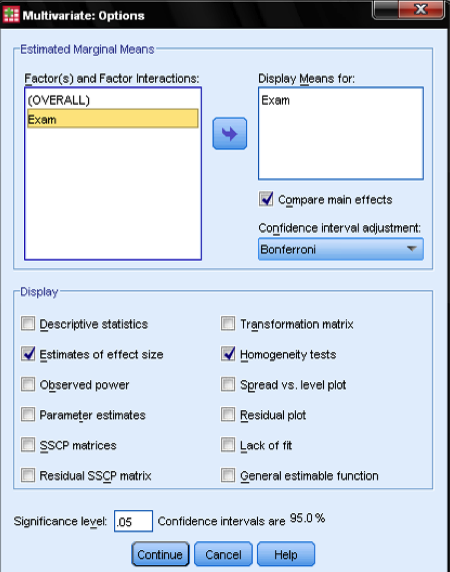Conduct and Interpret a One-Way MANCOVA
What is the One-Way MANCOVA?
MANCOVA is short for Multivariate Analysis of Covariance. The words “one” and “way” in the name indicate that the analysis includes only one independent variable. Like all analyses of covariance, MANCOVA combines a One-Way MANOVA with a regression analysis.
In basic terms, the MANCOVA looks at the influence of one or more independent variables on one dependent variable while removing the effect of one or more covariate factors. To do that the One-Way MANCOVA first conducts a regression of the covariate variables on the dependent variable. Thus it eliminates the influence of the covariates from the analysis. First, the residuals (unexplained variance in the regression model) undergo an MANOVA. This tests whether the independent variable still influences the dependent variables after removing the covariate(s) influence.
The One-Way MANCOVA includes one independent variable, one or more dependent variables and the MANCOVA can include more than one covariate, and SPSS handles up to ten. If the One-Way MANCOVA model has more than one covariate it is possible to run the MANCOVA with contrasts and post hoc tests just like the one-way ANCOVA or the ANOVA to identify the strength of the effect of each covariate.
The One-Way MANCOVA is most useful for two things: 1) explaining a MANOVA’s within-group variance, and 2) controlling confounding factors. Firstly, as explained in the section titled ‘How To Conduct a MANOVA,’ the analysis of variance splits the total variance of the dependent variable into:
- Variance explained by each of the independent variables (also called between-groups variance of the main effect)
- Variance explained by all of the independent variables together (also called the interaction effect)
- Unexplained variance (also called within-group variance)
Need help conducting your analysis? Leverage our 30+ years of experience and low-cost same-day service to complete your results today!
Schedule now using the calendar below.
The One-Way MANCOVA looks at unexplained variance. Atries to explain some with the covariate(s), increasing the power of the MANOVA.
Note: Overfitting can occur, as adding more covariates explains more variance but reduces degrees of freedom. Entering a weak covariate decreases statistical power. It removes the covariates’ effects on the relationship between independent and dependent variables, similar to partial correlation analysis. Technically, MANCOVA is a semi-partial regression and correlation.
It needs at least four variables:
- The independent variable groups cases into two or more levels. It must be at least nominal in scale.
- The independent variable influences two or more dependent variables. These must be continuous (interval or ratio), homoscedastic, and multivariate normal.
- Covariates, or confounding factors, moderate the independent variable’s impact on the dependents. They must be continuous (interval or ratio). In One-Way MANCOVA, a covariate is often a pre-test or baseline value.
The One-Way MANCOVA in SPSS
One-Way MANCOVA is part of SPSS General Linear Models. The GLM procedure allows 1–10 covariates. Without a covariate, it produces MANOVA results. Define measurement levels upfront for accuracy.
Let us analyze the following research question:
Does the score achieved in the standardized math, reading, and writing test depend on the outcome of the final exam, when we control for the age of the student?
Here, the three test scores are the dependent variables. The exam outcome (pass vs. fail) is the independent variable. The student’s age is the covariate.
The One-Way MANCOVA can be found in Analyze/General Linear Model/Multivariate…
A click on this menu entry brings up the GLM dialog, which allows us to specify any linear model. For MANCOVA design we need to add the independent variable (exam) to the list of fixed factors. [Remember that the factor is fixed, if it is deliberately manipulated and not just randomly drawn from a population. In our MANCOVA example this is the case. This also makes the ANCOVA the model of choice when analyzing semi-partial correlations in an experiment, instead of the partial correlation analysis which requires random data.]
We need to specify a full-factorial model where the covariate is the students’ age, and the dependent variables are the math, reading, and writing test scores. In the dialog box Model… we leave all settings on the default. The default for all GLM (including the MANCOVA) is the full factorial model.
The field post hocs is disabled when one or more covariates are entered into the analysis. If we want to include a group comparison into our MANCOVA we would need to add contrasts to the analysis. To compare all groups against a specific group, select Simple as the Contrast Method. Specify whether the analysis compares the first or last group against all others.
In the Options… dialog we can specify the additional statistics that SPSS is going to calculate. It is useful to include the marginal means for the factor levels and also to include the Levene test of homogeneity of error variances and the practical significance eta.
If the MANCOVA is a factorial MANCOVA and not a One-Way MANCOVA, i.e., includes more than one independent variable, you could choose to compare the main effects of those independent variables. The MANCOVA output would then include multiple ANOVAs that compare the factor levels of the independent variables. However, even if we adjust the confidence interval using the Bonferroni method, conducting multiple pairwise ANOVAs will multiply the error terms. Thus this method of testing main effects is typically not used anymore, and has been replaced by multivariate tests, e.g., Wilk’s’ Lambda.

If you’re like others, you’ve invested a lot of time and money developing your dissertation or project research. Finish strong by learning how our dissertation specialists support your efforts to cross the finish line.


